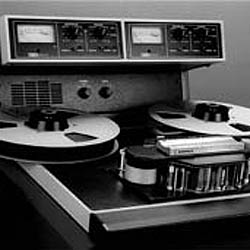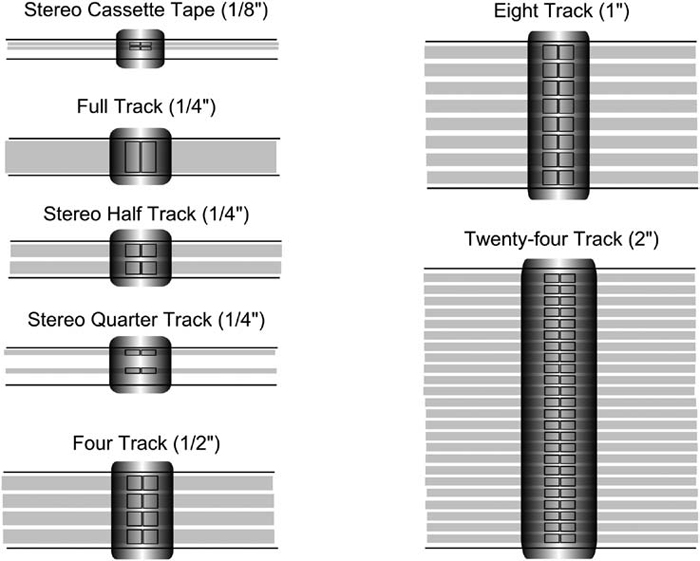
Tape, Tape Speed, And Head Configurations
Professional analog ATRs are currently available in a wide range of track- and tape-width configurations.
The most common analog configurations are 2-track mastering machines that use tape widths of 1/4 inch, 1/2 inch, and even 1 inch, as well as 16- and 24-track machines that use 2-inch tape.
Figure 6 details many of the tape formats that can be currently found. Optimal tape-to-head performance characteristics for an analog ATR are determined by several parameters: track width, head-gap width and tape speed.
In general, track widths are on the order of 0.080 inch for a 1/4-inch 2-track ATR; 0.070 inch for 1/2-inch 4-track, 1-inch 8-track, and 2-inch 16-track formats or 0.037 inch for the 2-inch 24-track format.
As you might expect, the greater the recorded track width, the greater the amount of magnetism that can be retained by the magnetic tape, resulting in a higher output signal and an improved signal-to- noise ratio. The use of wider track widths also makes the recorded track less susceptible to signal-level dropouts.
The most common tape speeds used in audio production are 15 ips (38 cm/ sec) and 30 ips (76 cm/sec).
Although 15 ips will eat up less tape, 30 ips has gained wide acceptance in recent years for having its own characteristic sound (often having a tighter bottom end), as well as a higher output and lower noise figures (which in certain cases eliminate the need for noise reduction).
On the other hand, 15 ips has a reputation for having a “gutsy,” rugged sound.
Print-Through
A form of deterioration in a recording’s quality, known as print-through, begins to occur after a recording has been made.
This effect is the result of the transfer of a recorded signal from one layer of tape to an adjacent track layer by means of magnetic induction, which gives rise to an audible false signal or pre-echo on playback.
The effects of print-through are greatest when recording levels are very high, and the effect decreases by about 2 dB for every 1-dB reduction in signal level. The extent of this condition also depends on such factors as length of storage, storage temperature and tape thickness (tapes with a thicker base material are less likely to have severe print-through problems).
Because of the effects of print-through, the standard method of professionally storing a recorded analog tape is in the tails-out position.
Remember:
—Professional analog tape should always be stored tails-out (on the right- hand take-up reel).
—Upon playback, the tape should be wound onto the left-most “supply reel.”
—During playback, feed the tape back onto the right-hand take-up reel, after which time it can again be removed for storage.
—If the tape has been continuously wound and rewound during the session, it’s often wise to rewind the tape and then smoothly play or slow-wind the tape onto the take-up reel, after which time it can be removed for storage.

